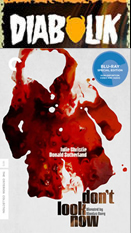
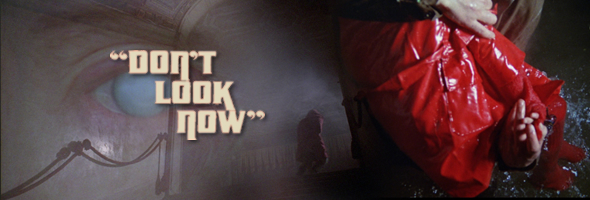
Color, 1973, 110m.
Directed by Nicolas Roeg
Starring Julie Christie, Donald Sutherland, Hilary Mason, Clelia Matania, Renato Scarpa
Criterion (Blu-ray & DVD) (US RA/R1 HD/NTSC), Optimum (Blu-ray & DVD) (UK RB/R2 HD/PAL), Arthaus (DVD) (Germany R2 PAL), Pulp (Blu-ray & DVD) (Italy RB/R2 HD/PAL) / WS (1.85:1) (16:9)
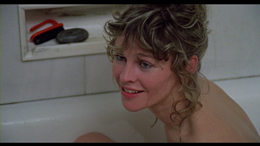
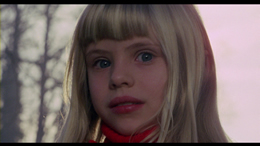 appearance in the BFI's top ten British films of all time), Don't Look Now has remained an oddly hidden cult favorite in America despite the controversy it stirred up in the 1970s. Arguably the most commercial and, in many respects, completely satisfying film by the erratically brilliant Nicolas Roeg (The Man Who Fell to Earth, Performance), this stylish and provocative psychic thriller has lost little of its power to challenge, shock, and amaze. The narrative, based very closely on a short story by Daphne du Maurier (Rebecca, The Birds), seems like a fairly straightforward supernatural tale, but the execution here is a different matter entirely.
appearance in the BFI's top ten British films of all time), Don't Look Now has remained an oddly hidden cult favorite in America despite the controversy it stirred up in the 1970s. Arguably the most commercial and, in many respects, completely satisfying film by the erratically brilliant Nicolas Roeg (The Man Who Fell to Earth, Performance), this stylish and provocative psychic thriller has lost little of its power to challenge, shock, and amaze. The narrative, based very closely on a short story by Daphne du Maurier (Rebecca, The Birds), seems like a fairly straightforward supernatural tale, but the execution here is a different matter entirely.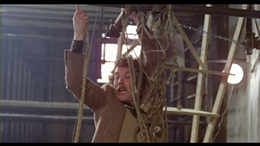 daughter is expressing happiness and messages of reassurance from the afterlife. Gradually the couple attempts to heal the damage wrought by grief, but the streets of Venice are haunted by a series of gruesome murders, the bodies found drifting in the canals. Furthermore, John's visions have begun and may be related to the strange figure in a red coat lurking in Venice's darkest corners. Is it Christine sending him a message... or something more sinister?
daughter is expressing happiness and messages of reassurance from the afterlife. Gradually the couple attempts to heal the damage wrought by grief, but the streets of Venice are haunted by a series of gruesome murders, the bodies found drifting in the canals. Furthermore, John's visions have begun and may be related to the strange figure in a red coat lurking in Venice's darkest corners. Is it Christine sending him a message... or something more sinister? 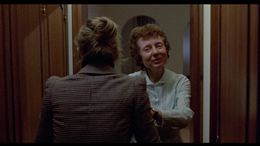 genuinely shocking surprise finale, truly one of the genre's most nightmarish climaxes. On a deeper level it's a meditation on the tricky nature of perception and fate where human destiny can be thwarted by a simple misreading of the signs hidden in everyday reality. Christie and Sutherland are both at their peak here, matched all the way by Roeg's impeccable sense of visual composition and a dizzying series of symbols which somehow manage to coalesce perfectly at the end, even if they don't all quite make rational sense. The lyrical score was the first ever composed by Pino Donaggio, who went on to Brian De Palma's most famous Hitchcockian thrillers; incidentally, according to interviews, Donaggio was picked when the film's producer has an inspired vision while spotting the composer on a gondola during location scouting in Venice.
genuinely shocking surprise finale, truly one of the genre's most nightmarish climaxes. On a deeper level it's a meditation on the tricky nature of perception and fate where human destiny can be thwarted by a simple misreading of the signs hidden in everyday reality. Christie and Sutherland are both at their peak here, matched all the way by Roeg's impeccable sense of visual composition and a dizzying series of symbols which somehow manage to coalesce perfectly at the end, even if they don't all quite make rational sense. The lyrical score was the first ever composed by Pino Donaggio, who went on to Brian De Palma's most famous Hitchcockian thrillers; incidentally, according to interviews, Donaggio was picked when the film's producer has an inspired vision while spotting the composer on a gondola during location scouting in Venice. 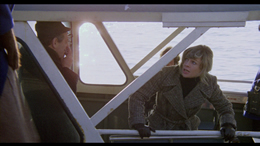 least partially blamed for Warren Beatty dumping Christie around the same time. Furthermore, various sources reported that Roeg had shot additional explicit footage that never made it into the final cut. That made a bit more sense when the first DVD appeared in Germany in 2001, featuring a transfer prepared in conjunction with the BFI and Canal Plus that allowed a comparison between the European cut and the U.S. print released on VHS by Paramount. It turns out the rest of the world got a completely different, more explicit cut of the love scene, with a few fleeting shots that stepped over the line of an R rating in even in the lenient '70s. The same satisfying transfer was also utilized for a variety of other European releases from Studio Canal or one of its affiliates, and that international cut has remained the standard ever since with the U.S. cut
least partially blamed for Warren Beatty dumping Christie around the same time. Furthermore, various sources reported that Roeg had shot additional explicit footage that never made it into the final cut. That made a bit more sense when the first DVD appeared in Germany in 2001, featuring a transfer prepared in conjunction with the BFI and Canal Plus that allowed a comparison between the European cut and the U.S. print released on VHS by Paramount. It turns out the rest of the world got a completely different, more explicit cut of the love scene, with a few fleeting shots that stepped over the line of an R rating in even in the lenient '70s. The same satisfying transfer was also utilized for a variety of other European releases from Studio Canal or one of its affiliates, and that international cut has remained the standard ever since with the U.S. cut 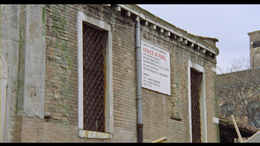 now likely to never see the light of day again. Interestingly, the German disc is still worth keeping as it features optional German and English soundtracks, as well as optional German and English subtitles. The English subs come in particularly handy, as they translate much of the Italian dialogue which remained incoherent in all previous versions and actually clarifies a bit of the background action involving the killer on the loose. The disc also includes the original British Lion theatrical trailer, which is nearly identical to the one prepared by Paramount.
now likely to never see the light of day again. Interestingly, the German disc is still worth keeping as it features optional German and English soundtracks, as well as optional German and English subtitles. The English subs come in particularly handy, as they translate much of the Italian dialogue which remained incoherent in all previous versions and actually clarifies a bit of the background action involving the killer on the loose. The disc also includes the original British Lion theatrical trailer, which is nearly identical to the one prepared by Paramount. 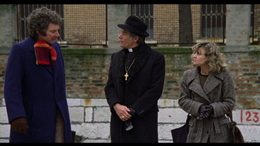 Alan Jones, and a great 20-minute video interview with Donaggio (in his beloved Venice) talking about how he got his first scoring gig and made the transition from a successful songwriter and singer. Carried over from the prior disc is the featurette "Looking Back," in which Roeg, editor Graeme Clifford, and cinematographer Anthony Richmond offer a thumbnail sketch through the making of the film.
Alan Jones, and a great 20-minute video interview with Donaggio (in his beloved Venice) talking about how he got his first scoring gig and made the transition from a successful songwriter and singer. Carried over from the prior disc is the featurette "Looking Back," in which Roeg, editor Graeme Clifford, and cinematographer Anthony Richmond offer a thumbnail sketch through the making of the film.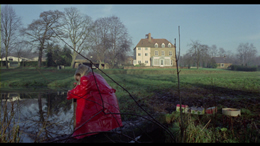
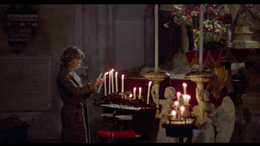 optional English subtitles are provided. The "Looking Back" featurette, the Paramount trailer, and the Donaggio interview are included here along with the trailer, but otherwise it's all-new material here in the extras. Clifford appears for a new interview with film writer Bobbie O'Steen, spending a dense 43 minutes talking about everything from getting the job (thanks to Julie Christie after they finished shooting McCabe and Mrs. Miller) to hitting it off with Roeg and coming up with wild editing ideas for the film's stream of consciousness approach. Particularly interesting is the discussion of the famous rapid-fire montage during the climax, just one of the many disorienting and distancing effects employing in the film's eccentric construction. In "Something Interesting," you get a half-hour collection of recent(ish) interviews with Richmond, Scott, Christie, and Sutherland, with an emphasis on the very specific, cut-related nature of the direction of the film. Sutherland's anecdote about shooting the love scene is pretty great, too. In the 14-minute "The Enigma of Film," Danny Boyle and Steven Soderbergh offer their own takes of Roeg's cinema including the explosion of concepts of time in his films and the adventurous nature of his best work, not to mention humorous shout outs to their own swipes from his work in Out of Sight and Trainspotting. Finally we have a 47-minute Q&A with Roeg at London's Cine Lumiere about the film, covering topics from the role of dialogue in his films to the subjective nature of temporal experience and memory, not to mention how he chose to shoot Venice with an avoidance of the usual tourist imagery. (There's a fun shout out to The Magic Christian, too.) Finally the release comes packaged with liner notes by critic David Thompson entitled "Seeing Red," creatively printed on the reverse side of an appropriately macabre fold-out map of Venice. Bring it along on your next trip to Italy and see where it takes you.
optional English subtitles are provided. The "Looking Back" featurette, the Paramount trailer, and the Donaggio interview are included here along with the trailer, but otherwise it's all-new material here in the extras. Clifford appears for a new interview with film writer Bobbie O'Steen, spending a dense 43 minutes talking about everything from getting the job (thanks to Julie Christie after they finished shooting McCabe and Mrs. Miller) to hitting it off with Roeg and coming up with wild editing ideas for the film's stream of consciousness approach. Particularly interesting is the discussion of the famous rapid-fire montage during the climax, just one of the many disorienting and distancing effects employing in the film's eccentric construction. In "Something Interesting," you get a half-hour collection of recent(ish) interviews with Richmond, Scott, Christie, and Sutherland, with an emphasis on the very specific, cut-related nature of the direction of the film. Sutherland's anecdote about shooting the love scene is pretty great, too. In the 14-minute "The Enigma of Film," Danny Boyle and Steven Soderbergh offer their own takes of Roeg's cinema including the explosion of concepts of time in his films and the adventurous nature of his best work, not to mention humorous shout outs to their own swipes from his work in Out of Sight and Trainspotting. Finally we have a 47-minute Q&A with Roeg at London's Cine Lumiere about the film, covering topics from the role of dialogue in his films to the subjective nature of temporal experience and memory, not to mention how he chose to shoot Venice with an avoidance of the usual tourist imagery. (There's a fun shout out to The Magic Christian, too.) Finally the release comes packaged with liner notes by critic David Thompson entitled "Seeing Red," creatively printed on the reverse side of an appropriately macabre fold-out map of Venice. Bring it along on your next trip to Italy and see where it takes you.